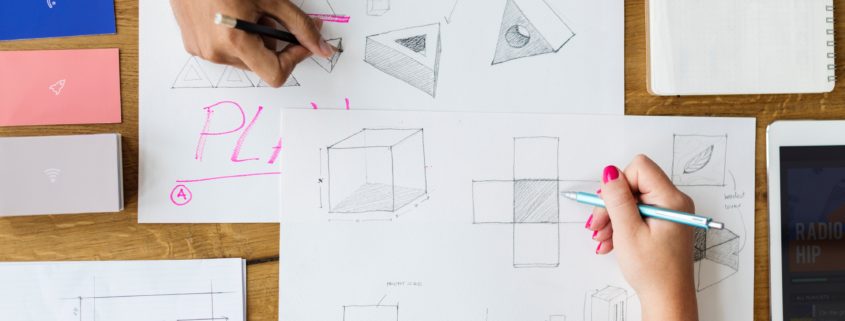The Power of Equitable Design (And 3 Tips to Become a More Inclusive Communicator)
By Eleni Stamoulis
“Design creates culture.”
One of my professors from grad school said this to my class when teaching us about the ethics of graphic design. He then showed us national campaigns he designed that sexualized women or encouraged young people to smoke. He was not proud of these successful designs, but shared them with us to show what our responsibilities were as young designers. It was the first time I realized that my work as a graphic designer has a much larger impact than simply conveying information in a visually appealing way.
Since starting at Mission Partners, I’ve been able to see first hand the impact design has on how messages are received and audiences are engaged (or left behind). Every day, we think about these intended and unintended consequences in our work, realizing that there’s design in everything we do and every decision we make—whether designer is in our title or not. We practice inclusive marketing and equitable design, which works to create social change through design and reflects our diverse world. In essence, it is “design for good.”
We are a visual society. With the explosion of social media, the visual literacy of our culture has only increased. Think of how many platforms are purely image-based and why social content with images produce 180% more engagement—Images are a common language we can all understand. But, if you were to go through today building a collection of all the images you see on social media and in digital advertising, what do you think you’d find? And what—or who—might be missing? In inclusive marketing and equitable design, the images and graphics that are being put out into the world should reflect the diverse and accepting world we want for the future—a world with less hate.
As I reflect on my own growing practice of equitable design, I wanted to share the top three tips that I think can benefit all communicators—including those who don’t have “designer” in their title:
1. Be more intentional about stock photography.
It’s important to show a variety of races, cultures, genders, sexual orientation, ages, abilities, and body types. But also be aware of the positioning and context of the photo. For example, in a recent project, a coworker sent me this photo to use. The image depicts a brainstorming session in a workplace, with a mature, white man in the center writing on the glass wall, with a Black woman on the right and a white woman on the left. While it’s a great photo, it shows the white, male figure as the leader, consequently putting both women in a subordinate role. The image subtly perpetuates the societal notion that white, males are the leaders in the workplace. Instead I sent my coworker two alternative images to use—both are similar brainstorming sessions with sticky notes on the wall. The first shows an Asian woman at the front of the group and the second photo, a Black woman (actually the same Black woman from the original photo). These two images conveyed the same message, but a woman of color was in the leadership position. While this may seem subtle, it’s a small way to challenge existing assumptions and stereotypes. My favorite sites for diverse, free stock images are Unsplash.com, Pexels.com, Burst by Shopify, and Nappy.co. (If you can invest some money into stock imagery, I suggest PhotoAbility.net and BodyLiberation.com for great photos of people with differing abilities and body shapes, respectively)
2. Make your design accessible for people with differing abilities.
Don’t forget that inclusive marketing materials and equitable designs don’t just consider what goes into the final product, but who will see and read them. It can feel overwhelming to think about all the accessibility issues that need to be addressed, but your social media is a great first place to begin. Start by adding alt text to your images so people with visual impairments can enjoy them as well. Alt text, or alternative text, is used to convey the information that the visual represents when it cannot be seen by the user. For people using screen readers, this is the text that is used to explain the photo or image. Adding it is slightly different for each platform so simply Google “How to add alt text on [insert social media platform]” to find out how. Other ways you can ensure accessibility in your designs is to run graphics through a colorblind simulator or add captions to a video.
3. Make sure the images match the words/message.
When all is said and done, words are unbeatable in their ability to be precise and detailed. It is important that your message is consistent across both the visuals and the written language. Not only will the message be clearer for your audience, it will be a more powerful, memorable, and lasting message.The visuals of a project are often dictated by the message, so it’s important to make sure your message is clear/provides a solid foundation to build on. If you’re interested in creating a message centered on equity or in getting more tips on the good work you’re already doing, register for one of our Mission Forward® workshops on equity. We host two separate workshops that can help you be more equitable in your language:
- Race + Identity Workshop works on building shared language for addressing and reducing harmful environments at work, providing guidance on effective practices and the latest language around diversity, equity and inclusion. Our two-pronged approach addresses both institutionalized racism and oppression as well as the interpersonal racism and oppression.
- Equity + Design Thinking Workshop helps you work through your stickiest communication challenge. You’ll learn how to apply a human-centered, equity lens to very specifically to your communications materials, messages and process. Our team will help you work through your current or upcoming communication materials to make sure you are communicating through an equity lens and finding the right solutions to the problem.
As Antionette Carroll, founder and creative visionary of Creative Reaction Lab has said, “Design is the intentional and unintentional impact behind an outcome.” And, as we often remind our clients and workshop attendees, we are ALL designers, even if we don’t have the degree or title. Every decision we make, every message we develop, has consequences and can easily reinforce or break long held stereotypes and biases. There’s great power in design—and equitable design ensures that you can use that power for good.




 Check out our new
Check out our new